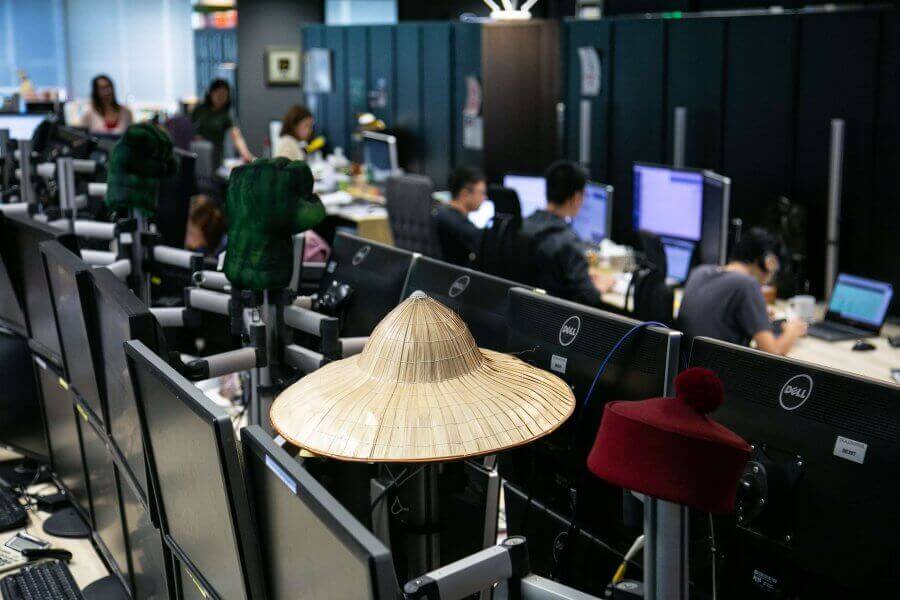
Grasshopper: Punching Above Its Weight
How a Singapore Fintech is winning the
war for talent with its unique culture
It is almost a cliche that employees are motivated primarily by money, and nowhere is this belief stronger than in the financial services industry. Many roles are measured and remunerated directly according to the profits each person generates, and this can create a tendency to zero in on money as a measure of success. However, while money is undoubtedly important, other motivators can be equally powerful in deciding whether talent accepts a job offer or stays on in a role.
Grasshopper Asia is a leading Singaporean proprietary trading firm providing liquidity in global markets. Since it was founded by John Lin in 2006, it has grown and prospered into a dynamic team of 70 individuals. Powered by their custom-built trading platform, they have continued to find profitable strategies through global financial crises, pandemics, and all manner of macro- and micro-economic shocks.
Grasshopper CEO James Leong joined the firm way back in 2006 as the very first trader, and has personally seen, and driven, the growth of the company over the last 15 years. James has a somewhat unusual background for a CEO of a proprietary trading firm, since his background is in organizational psychology – in fact, he used to work as a psychologist at the Ministry of Defence before joining Grasshopper. This unique combination of training in behavioural science and in-depth knowledge of the industry has enabled James to leverage the people side of the business to Grasshopper’s advantage.
TalentKraft has worked with Grasshopper on a range of topics, from employer branding and interview process improvements, to competency mapping and performance management. We spoke to James to find out more about the secrets of their success on the people front, and how this has driven their business success.

What are some common myths about talent in your industry?
J: Compensation is just one piece of the puzzle. When financial incentives are the only metrics for making judgements, it is inevitable that your talent will necessarily move once a better offer is available elsewhere.
Contrary to Gordon Gekko’s “Greed is good” mantra, we have repeatedly found that smart, capable people often seek personal growth, autonomy and a community that challenges and values them. These have proven to be critical requirements for attracting and retaining talented individuals.
Another common myth is that banking is the main source for talent in our industry. While we are a trading firm, a large proportion (>50%) of the firm’s talent is based around technology. We compete with just about every major corporation for software, database and infrastructure engineers. We have successfully hired (and lost people to) from FAANGs, successful technology startups, other trading firms, and banks.
The diversity of our talent pool raises the stakes for us. People are the core of Grasshopper, and losing a good contributor can be painful and expensive. Recognising this, we updated and optimised our branding, hiring and welfare policies some years ago – which I think is critical for us to continue to be successful.

How has Grasshopper’s focus on talent translated into success for the business?
J: Grasshopper has put a lot of effort into coming out of our shell over the last few years. We actively communicate authentic views from inside the company, whether through mainstream media relationships, social media, or partners like TalentKraft. When prospective applicants contact us, they usually come with an initial perspective on how their skill-sets and competencies factor into the larger organisation, and what it is about Grasshopper that can contribute to their own career success.
Here are some examples.
1. We take pains to ensure that our external facing communications are very clear about representing our culture and values, so that we attract like-minded individuals who feel that they can thrive in Grasshopper. Grasshopper is run like a start-up: with a flat structure that encourages individuals to take the initiative to work on matters that deliver value. As such, many who thrive in our organisation are the ones who would chafe at a hierarchical and defined way of working.
2. We have worked hard to ensure that our selection process is focused and targeted, despite the small size of our HR team. One thing we did right was to engage TalentKraft’s help, to streamline the process while ensuring that we were focused on the appropriate competencies for each position. This reduced our average man-hours spent by senior managers to fill each position, and also improved the outcomes for each candidate when they were hired.
3. Finally, our executive management spends a lot of time focused on people. From welfare to personal and professional development, we invest significant effort into ensuring that people feel supported and are given sufficient opportunities to grow. Grasshopper’s turnover rate – for a technology-based trading firm competing against billion-dollar behemoths – has never exceeded 10-15% on a yearly basis.
“One thing we did right was to engage TalentKraft’s help, to streamline the process while ensuring that we were focused on the appropriate competencies for each position.”

James Leong
CEO of Grasshopper
What do you think is driving this?
The baseline for every organisation is its people and culture. John (the founder) and I originally got to know each other in a competitive sports team that always felt stronger than the sum of its parts. These were the values we brought into the journey of building Grasshopper: valuing people, building them up, and nurturing good habits.
The value of a strong and compelling culture grew into an abiding goal: to build a place of work that drove and challenged people, while being a safe psychological space. We wanted the work environment to be a place, both physical and virtual, that brought excitement, growth and community.
To achieve this, we emphasised transparency. Our people are constantly equipped with the best available information in order to make the best decisions. We also ensure they have the autonomy and authority to make decisions. Team leaders are consistently empowered to decide on resources and request for infrastructure or support, which allows management to focus on strategy, cross-functional issues, and culture/people priorities.

What are some sacrifices or tradeoffs that you have had to make to achieve this?
J: Team leaders and management spend a large amount of energy in ensuring that people understand the very complex context of strategic decisions. Given that the majority of the tactical and resource decisions are made on the ground, this is critical to the continued success of Grasshopper.
We also spend a fair bit of effort ensuring that issues of appraisal, compensation and benefits are up to date and progressively maintained. This requires a lot of buy-in from team leads, who typically consider such matters “administrative”, and detracting from their preferred ways of using their time. Fortunately, our team leads are long-term Grasshoppers who appreciate the value of creating a strong environment for growth, empowerment and accountability.
How do you intend to continue to stay ahead?
J: It sounds like a cliche, but Grasshopper’s commitment to its people is its edge and will continue to be the focal point of management’s efforts. We believe unequivocally that people will grow if given the opportunity and proper guidance – whether it’s with tangible work-related competencies or in less tangible soft skills.
We continue to invest in our people, not just because we live on the cutting edge of technology and trading, but also because we recognise the tremendous opportunity cost of a poorly executed idea or badly communicated initiative.
As a little giant in the finance world, this continues to help differentiate Grasshopper from more established, multinational firms in both technology and finance. We may not be the right flavour for everyone, but we have found a formula that attracts capable, driven and responsible individuals that help us compete with the world’s best.

